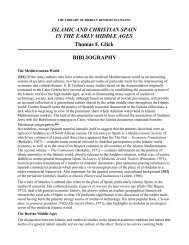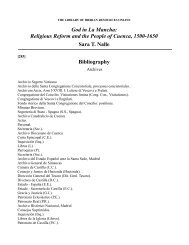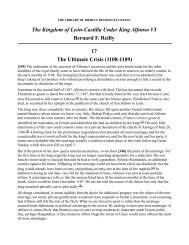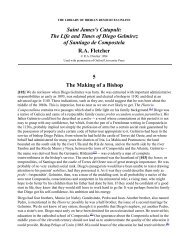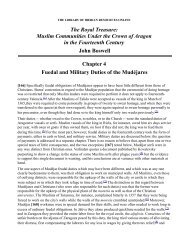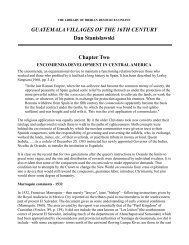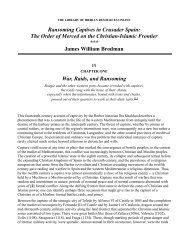The Cluniac Priories of Galicia and Portugal - The Library of Iberian ...
The Cluniac Priories of Galicia and Portugal - The Library of Iberian ...
The Cluniac Priories of Galicia and Portugal - The Library of Iberian ...
You also want an ePaper? Increase the reach of your titles
YUMPU automatically turns print PDFs into web optimized ePapers that Google loves.
more likely [314] that his generosity to La Chanté was determined by that <strong>of</strong> Henry <strong>and</strong> Teresa two<br />
years before than the reverse.<br />
As for Henry himself, family ties may well have been influential. He was a gr<strong>and</strong>son <strong>of</strong> Hélie de<br />
Semur, <strong>and</strong> we know that the counts <strong>of</strong> Semur became patrons <strong>of</strong> La Charité, although unfortunately<br />
we cannot document this before 1162. (27) But behind the gift to what was then probably Cluny's most<br />
flourishing dependency there almost certainly lies a more decisive political factor, connected with the<br />
whole program <strong>of</strong> ecclesiastical <strong>and</strong> political autonomy then being vigorously pursued by the ambitious<br />
Count <strong>of</strong> <strong>Portugal</strong>. (28) By 1100 the intimate association, paternalistic <strong>and</strong> quasi-feudal, <strong>of</strong> Hugh <strong>of</strong><br />
Cluny with Alfonso VI had given the abbey a powerful influence in dynastic <strong>and</strong> imperial affairs. We<br />
may be sure that Henry was fully aware <strong>of</strong> the secular as well as spiritual advantages in Burgundian<br />
gratitude <strong>and</strong> friendship. But the gift <strong>of</strong> a monastery <strong>and</strong> <strong>of</strong> annual revenues directly to Cluny, with the<br />
accompanying entry <strong>of</strong> the donor or donors into the abbey's societas, entailed from this st<strong>and</strong>point<br />
certain drawbacks. It was likely to be overshadowed by, even worse, confused with, the king-emperor's<br />
own much greater beneficences, his string <strong>of</strong> monastic cessions <strong>and</strong> famous doubled census <strong>of</strong> 2000<br />
gold metcales a year. <strong>The</strong> abbatial chamberlain sent annually to Spain by Hugh to collect the census<br />
<strong>and</strong> visit the peninsular priories could be expected to champion in <strong>Portugal</strong> the interests <strong>of</strong> Alfonso VI.<br />
And the priory itself, as may already have been happening with the older houses in León, would tend to<br />
fall into administrative dependence upon Cluny's chief western Hispanic center, San Isidro de Dueñas,<br />
a natural stronghold <strong>of</strong> Leonese imperialism. It is then as a counterpart to the steps Henry is known. to<br />
have been taking before <strong>and</strong> after 1100 to strengthen comital power <strong>and</strong> independence in <strong>Portugal</strong> that<br />
his gift to La Charité, not the mother abbey, is most logically explained. From 1100 on he had a firm<br />
line [315] <strong>of</strong> connection with the <strong>Cluniac</strong>s that Abbot Hugh would recognize, a distinctly Portuguese<br />
line quite separate from that <strong>of</strong> the monarch <strong>of</strong> imperial León.<br />
3. 4 February 1102: SANTA JUSTA DE COIMBRA: <strong>Portugal</strong>, Beira Litoral, in the parish <strong>of</strong> this name<br />
adjoining that <strong>of</strong> the celebrated monastery <strong>of</strong> Santa Cruz, in the suburbium <strong>of</strong> Coimbra to the N or NW<br />
<strong>of</strong> the city. (29) This second <strong>of</strong> Cluny's Portuguese acquisitions was presented to La Charité by Bishop<br />
Maurice Bourdin <strong>and</strong> the cathedral chapter <strong>of</strong> Coimbra through a mediator, Gaufredus, who is probably<br />
to be identified with the Compostelan archdeacon <strong>of</strong> this name, a close associate <strong>of</strong> Bishop Diego<br />
Gelmírez. (30) This is the only dependency the <strong>Cluniac</strong>s came to possess in trans-Douro <strong>Portugal</strong>, <strong>and</strong> it<br />
was evidently <strong>of</strong> modest size: we hear <strong>of</strong> the ecclesia sancte Iuste <strong>and</strong> its conversion into a hospice<br />
before the transfer, but not <strong>of</strong> appurtenances. [316] As an episcopal cession Santa Justa is unique<br />
among grants <strong>of</strong> monasteries to Cluny anywhere in the Leonese-Castilian state; <strong>and</strong> its exemptive rights<br />
were narrowly restricted since the monks owed the bishop <strong>of</strong> Coimbra fidelity, obedience <strong>and</strong> respect<br />
for his ius episcopale totum, even though in return they were to be protected against attacks by pagani<br />
(Muslims) <strong>and</strong> lawless Christians. Presumably the expectation was that the monastic ecclesia would<br />
also serve as a parish church; by 1137 <strong>and</strong> ca. 1155 we have specific references to the parochia sanctae<br />
Iuste; (31) <strong>and</strong> this helps explain why the house has left no traces in the La Charité documents or the<br />
confirmation <strong>of</strong> her possessions in 1144 by Pope Lucius II. (32)<br />
Nevertheless, small as Santa Justa de Coimbra may have been, it remains a <strong>Cluniac</strong> center until at least<br />
the last quarter <strong>of</strong> the 12th century; <strong>and</strong> the few texts that survive for its history, bearing as they do on<br />
resistance to the see <strong>of</strong> Coimbra in matters <strong>of</strong> boundaries <strong>and</strong> tithes, (33) warn against underestimating<br />
the degree <strong>of</strong> independence <strong>and</strong> vitality <strong>of</strong> this house.<br />
4. 22 February 1109: SAN VICENTE DE POMBEIRO : <strong>Galicia</strong>, dioc. <strong>and</strong> prov. Lugo, p. j. Monforte,<br />
ayunt. Pantón, ca. 17 kms. SW <strong>of</strong> Monforte de Lemos, at the confluence <strong>of</strong> the rivers Sil <strong>and</strong> Miño. (34)<br />
This ancient monasterio propio <strong>of</strong> the Leonese crown, originally a double house, while not in a class



